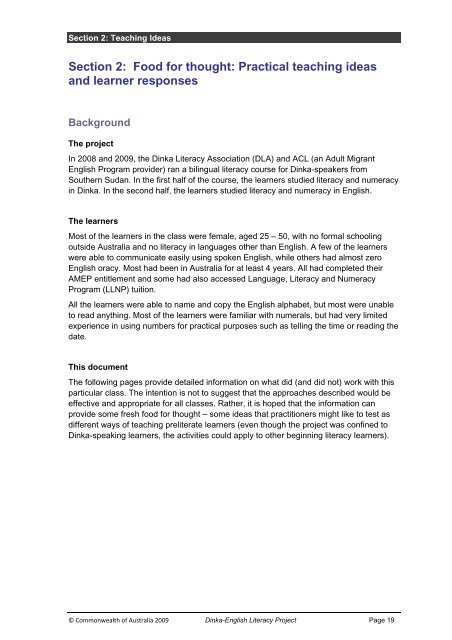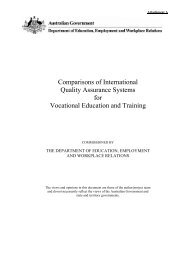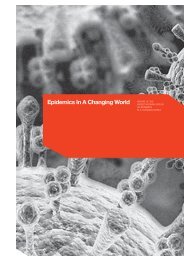First Language (Dinka) Literacy as a Foundation for English ...
First Language (Dinka) Literacy as a Foundation for English ...
First Language (Dinka) Literacy as a Foundation for English ...
Create successful ePaper yourself
Turn your PDF publications into a flip-book with our unique Google optimized e-Paper software.
Section 2: Teaching Ide<strong>as</strong><br />
Section 2: Food <strong>for</strong> thought: Practical teaching ide<strong>as</strong><br />
and learner responses<br />
Background<br />
The project<br />
In 2008 and 2009, the <strong>Dinka</strong> <strong>Literacy</strong> Association (DLA) and ACL (an Adult Migrant<br />
<strong>English</strong> Program provider) ran a bilingual literacy course <strong>for</strong> <strong>Dinka</strong>-speakers from<br />
Southern Sudan. In the first half of the course, the learners studied literacy and numeracy<br />
in <strong>Dinka</strong>. In the second half, the learners studied literacy and numeracy in <strong>English</strong>.<br />
The learners<br />
Most of the learners in the cl<strong>as</strong>s were female, aged 25 – 50, with no <strong>for</strong>mal schooling<br />
outside Australia and no literacy in languages other than <strong>English</strong>. A few of the learners<br />
were able to communicate e<strong>as</strong>ily using spoken <strong>English</strong>, while others had almost zero<br />
<strong>English</strong> oracy. Most had been in Australia <strong>for</strong> at le<strong>as</strong>t 4 years. All had completed their<br />
AMEP entitlement and some had also accessed <strong>Language</strong>, <strong>Literacy</strong> and Numeracy<br />
Program (LLNP) tuition.<br />
All the learners were able to name and copy the <strong>English</strong> alphabet, but most were unable<br />
to read anything. Most of the learners were familiar with numerals, but had very limited<br />
experience in using numbers <strong>for</strong> practical purposes such <strong>as</strong> telling the time or reading the<br />
date.<br />
This document<br />
The following pages provide detailed in<strong>for</strong>mation on what did (and did not) work with this<br />
particular cl<strong>as</strong>s. The intention is not to suggest that the approaches described would be<br />
effective and appropriate <strong>for</strong> all cl<strong>as</strong>ses. Rather, it is hoped that the in<strong>for</strong>mation can<br />
provide some fresh food <strong>for</strong> thought – some ide<strong>as</strong> that practitioners might like to test <strong>as</strong><br />
different ways of teaching preliterate learners (even though the project w<strong>as</strong> confined to<br />
<strong>Dinka</strong>-speaking learners, the activities could apply to other beginning literacy learners).<br />
© Commonwealth of Australia 2009 <strong>Dinka</strong>-<strong>English</strong> <strong>Literacy</strong> Project Page 19
















